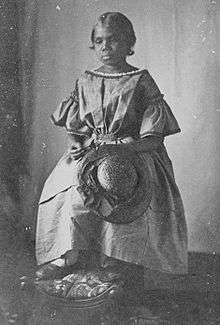Bessie Flower
| Bessie Flower | |
|---|---|
 Portrait of Bessie Flower as a child while at Annesfield. | |
| Born |
Elizabeth Flower ~1851 King George Sound, Western Australia |
| Died | 14 January 1895 |
| Occupation | Teacher |
| Spouse(s) | Donald Cameron |
Bessie Flower or Bessie Cameron (c.1851 - 1895) was a Minang Noongar woman from Albany, Western Australia. Flower was educated at Annesfield, and developed a strong connection to headmistress Anne Camfield. Throughout her life she fought for Aboriginal rights and to keep families together. In 1867 Flower relocated to the Ramahyuck Mission, in Gippsland, Victoria, where she worked as a teacher.[1]
Early life
Flower was born to John and Mary Flower some time near 1851. Her family were Nyungar aboriginal Australians and her parents worked for Henry and Anne Camfield. Henry was the government's representative and Anne started a school for native children which the Flower children attended. Bessie became a Christian and an outstanding pupil.[2]
Flower was described as an "intelligent and bright child".[3] She spoke French, played the harmonium, chess, and also excelled at the piano and singing. In 1864 she was sent to a Church of England 'model school' to further her studies. Upon returning to Annesfield in 1866, she worked alongside Anne Camfield as a teacher's assistant. Flower also worked as an organist at the local Anglican Church.[2]
In 1867 Flower was given an opportunity which appeared to provide her a chance to improve her teaching. She was offered a position at the mission in Gippsland in Victoria, but the real plan seemed to have been for her to become a wife to one of Friedrich Hagenauer's favourite converts.[2] Bessie's parents were both aboriginals whereas Hagenauer's convert, her husband designate, Adolph Donald Cameron, was a half caste. They married when Bessie was 17 and they had eight children. Both Adolph and Bessie left Hagenauer's employment but his influence continued.
According to Australian authorities, people who were not full-blooded aboriginals were to be separated from aboriginals. This meant that Bessie should be separated from her family. She found, therefore, that the authorities were trying to separate her from her children. The secretary of the board in charge of that decision, as it happened, was Friedrich Hagenauer himself.[2]
Meanwhile
In 1871 a Select Committee reported on the Aboriginal Natives. They summarised Anne Camfield's evidence saying "One girl, sent to Sydney, played for some time the harmonium in St. Philip’s Church, and gained her living by teaching...".[4]
References
- ↑ "Bessy Flower". Kaartdijin Noongar. Retrieved 7 May 2017.
- 1 2 3 4 Elizabeth (Bessy) (1851–1895) Cameron, Bain Attwood, ADB, Retrieved 19 May 2017
- ↑ Attwood, Bain (1986). '... In the name of all my coloured brethren and sisters...' : a biography of Bessy Cameron. pp. 47–53.
- ↑ “Handbook of Western Australia”, C G Nicolay, 1880